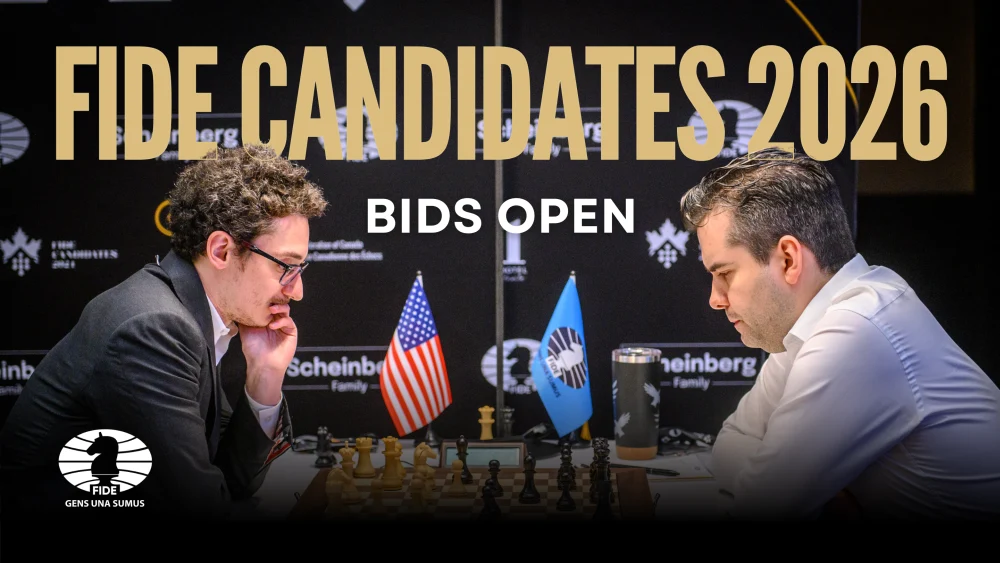The Candidates Tournament is one of the most important events in chess. Every two years, it determines who will challenge the reigning World Champion for the title. For fans, it is the gateway to the World Chess Championship. For players, it is the ultimate test of consistency, preparation, and nerves.
The 2026 Candidates Tournament will decide who faces Gukesh Dommaraju, the current World Champion, in the World Chess Championship match. Understanding how players qualify and how the event unfolds can seem complicated, but the process can be broken down step by step.
Step 1: Why the Candidates Exists
Chess has a unique system for crowning its World Champion. Unlike most sports, there is no single knockout tournament where the winner automatically becomes champion. Instead, the World Champion keeps the title until someone defeats them in a scheduled match.
The role of the Candidates Tournament is to select that challenger. Eight players compete in a double round-robin tournament—meaning everyone plays everyone else twice, once with White and once with Black. The winner earns the right to challenge the champion in a 14-game match.
Step 2: The 2026 World Championship Match
The World Championship match itself is scheduled for 2026, though the dates and location have not yet been announced. It will feature:
- The Defending Champion: Gukesh Dommaraju of India, who won the World Chess Championship 2024.
- The Challenger: The winner of the Candidates Tournament 2026.
The format of the championship match:
- 14 classical games.
- The first player to score 7.5 points wins.
- If the score is tied 7–7 after 14 games, the match is decided by rapid and blitz tiebreaks.
Step 3: Who Qualifies for the Candidates?
Eight players earn the right to play in the Candidates Tournament. For 2026, the qualification system has been adjusted to increase fairness and competitiveness.
Here are the five main qualification paths:
Path A: 2024 FIDE Circuit Winner (1 spot)
- The FIDE Circuit is a year-long ranking system based on performance across eligible tournaments.
- The 2024 Circuit winner already qualified: Fabiano Caruana of the United States.
- If the winner is already World Champion or otherwise qualified, the spot goes to the next in line according to FIDE’s replacement rules.
Path B: 2025 FIDE World Cup (3 spots)
- A massive knockout tournament where hundreds of players compete.
- The top three finishers earn Candidates spots.
- If one of them is already qualified, the place passes to the 4th-place finisher, or follows FIDE’s order of priority.
Path C: 2025 FIDE Grand Swiss (2 spots)
- A prestigious Swiss-system tournament, scheduled for September 3–15, 2025 in Samarkand, Uzbekistan.
- The top two finishers qualify directly.
Path D: 2025 FIDE Circuit Winner (1 spot)
- Just like 2024, but for the year 2025.
- Players accumulate points across tournaments, and the top scorer gets in.
Path E: Highest Average Rating (1 spot)
- A place is reserved for the highest-rated player, based on a six-month average rating from August 2025 to January 2026.
- To be eligible, a player must play at least 40 rated games during this period (with at least 15 in any six consecutive months).
- This rule prevents players from qualifying by simply “sitting” on a high rating—they must actively compete.
Step 4: What Changed in 2026
FIDE made several adjustments for the 2026 cycle:
- No automatic spot for the World Championship runner-up.
In the past, the player who lost the World Championship match got a free pass to the next Candidates. That is no longer the case. Instead, they must fight for qualification like everyone else. - Six-month rating average.
The rating spot is now determined by a six-month period, not 12 months or a single rating list. This encourages consistent activity rather than late-year “rating protection.” - FIDE Circuit revisions.
- Two spots now come from the Circuit (2024 and 2025).
- Circuit scores are based on a player’s top events (up to seven).
- Bonus points are awarded for sole first place.
- Unlimited events per country are allowed, provided they meet strength criteria.
These changes aim to keep the system competitive, prevent shortcuts, and ensure that the strongest and most active players make it into the Candidates.
Step 5: Replacements and Tie-Breaks
Chess is full of surprises—players may qualify through multiple paths, decline participation, or withdraw. FIDE has clear replacement rules to cover these situations. For example:
- If a World Cup qualifier is already World Champion or has qualified elsewhere, the 4th-place finisher gets in.
- If a Grand Swiss qualifier is unavailable, the 3rd-place finisher steps in.
- If the rating qualifier is already in, the spot shifts to the FIDE Circuit list.
In the Candidates itself:
- The tournament is a 14-round double round-robin.
- If two or more players tie for first place, a playoff determines the challenger.
Step 6: Why the Candidates Matters
The Candidates is often more dramatic than the championship match itself. With eight of the world’s best players clashing in a round-robin, every round brings decisive action. Unlike the World Championship, where one player defends and the other attacks, the Candidates is a free-for-all.
It has also produced historic storylines:
- In 2013, Magnus Carlsen won the Candidates to earn his first shot at the world title.
- In 2022, Ian Nepomniachtchi repeated as winner, proving his consistency at the elite level.
- The 2024 edition crowned Gukesh Dommaraju, who went on to dethrone Ding Liren and become the youngest World Champion in history.
The 2026 edition promises similar fireworks, with legends like Caruana competing alongside rising stars.
Step 7: Which path is the most controversial?
Among the five qualification paths, the most debated has always been the rating spot. On paper, it sounds simple: the highest-rated player over a defined period gets a seat at the Candidates. In practice, it has caused some of the fiercest controversies in recent memory.
The main issue is eligibility. Players can’t simply rely on their high Elo; they must also meet a minimum number of classical games during the qualifying period. This rule exists to prevent “sitting” on a rating without competing. But history shows that it has forced desperate last-minute campaigns.
Take Ding Liren in 2022. After Sergey Karjakin’s ban, the replacement was determined by rating. Ding was the natural frontrunner—but he had only played 4 rated games in nearly a year. To meet the 30-game requirement, the Chinese Chess Association scrambled to organize events: a quadruple round-robin in Hangzhou, a match with Wei Yi, and a 10-round qualifier. In less than a month, Ding played 28 classical games, scoring an astonishing 20.5/28, and became eligible just in time. The “quest” was criticized as artificial, but it secured him a Candidates spot.
Two years later, Alireza Firouzja faced similar scrutiny. After slipping behind Wesley So in the live rating list, Firouzja arranged a series of rapid-fire matches in Chartres against much lower-rated grandmasters. The setup was so unusual that FIDE had to issue new rules requiring top-level events to be registered at least a month in advance. Although Firouzja eventually overtook So by winning the modest Open de Rouen, the episode left a lasting stain on the credibility of the rating qualifier.
And now, in the 2026 cycle, the spotlight has shifted to Hikaru Nakamura. With his high rating, he is a clear contender for the spot. But the new requirement of 40 rated games has forced him into an unusual path—entering state championships like Louisiana and Iowa to rack up games against vastly lower-rated opponents. This has triggered debates about “rating farming,” a criticism Nakamura directly pushed back against in his recent statement: “I’m not farming for rating when I play at state Chess Championships.”
The controversy shows why the rating path, while designed to reward consistency and sustained excellence, is often the most fragile and politicized of all. It demands not just strength at the board, but also careful scheduling, federation support, and sometimes, improvisation under pressure.
FAQ: The Candidates Tournament
What is the Candidates Tournament in chess?
The Candidates is an elite event held every two years to determine who will challenge the reigning World Champion. Eight players qualify through different paths and face off in a double round-robin format.
How many players compete in the Candidates Tournament?
There are eight players. Each plays 14 games in total (two against every opponent, once with White and once with Black).
How does a player qualify for the Candidates?
There are five main paths:
- FIDE Circuit Winner (2024 and 2025 editions)
- Top finishers from the FIDE World Cup
- Top finishers from the FIDE Grand Swiss
- Highest average rating across six months
- Replacement rules, if a qualified player withdraws
Why is the rating spot so controversial?
Because it requires players not only to have a high rating, but also to play a minimum number of games. This has led to rushed, last-minute events, like Ding Liren’s marathon in 2022 and Alireza Firouzja’s Chartres matches in 2023. Now, Hikaru Nakamura’s push to reach 40 games in local tournaments has sparked new debate.
When and where will the next Candidates Tournament take place?
The 2026 Candidates is scheduled for later in 2025 in Samarkand, Uzbekistan, right after the FIDE Grand Swiss. Exact dates are still pending.
Who is already qualified for the 2026 Candidates?
- Fabiano Caruana (2024 FIDE Circuit Winner)
- More players will qualify via the 2025 World Cup, 2025 Grand Swiss, the 2025 FIDE Circuit, and the rating spot.
What does the winner of the Candidates get?
The winner becomes the official challenger to the reigning World Champion, currently Gukesh Dommaraju, in the 2026 World Chess Championship Match.
Has the qualification system changed recently?
Yes. For the 2026 cycle, FIDE removed the automatic spot for the World Championship runner-up, introduced the six-month average rating system, and revised the FIDE Circuit scoring rules to encourage consistent activity.
Why do players enter small local tournaments?
To meet the minimum number of classical games required for the rating path. For example, Hikaru Nakamura entered state championships in Louisiana and Iowa in 2025 to reach 40 games by the January 2026 deadline.
Why is the Candidates Tournament important for fans?
Because it’s often more dramatic than the championship match itself. With eight players fighting for one spot, every round matters, and storylines like Ding’s 2022 quest or Gukesh’s 2024 triumph make history.
Update on Sep 15: After the 2025 Grand Swiss, Anish Giri and Matthias Bluebaum joined Fabiano Caruana as confirmed Candidates.

I’m Xuan Binh, the founder of Attacking Chess, and the Deputy Head of Communications at the Vietnam Chess Federation (VCF). My chess.com and lichess rating is above 2300. Send me a challenge or message via Lichess. Follow me on Twitter (X) or Facebook.

